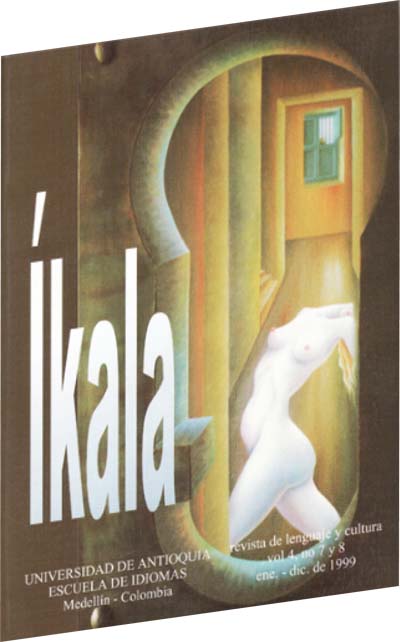From translation models and model translations to translation as a model: some implications for translation studies and teaching
DOI:
https://doi.org/10.17533/udea.ikala.8493Keywords:
history of translation, translation as a process, translation teaching, post-colonial translation.Abstract
The development of translation studies in recent years has allowed the discipline to acquire a new sense of identity. The focus has shifted away from the translation "product" to the translation "process*. The implications of these developments and trends need to be taken into account at curricular and methodological levels in the establishment of university programmes in translation studies. The quality of translation teaching can be enhanced by seeing translation as a metaphor and model of its own right and as an open-ended process which is democratic, participatory and creative.
Downloads
References
S. BASSNETT, A. LEFEVERE, Constructing cultures, Multilingual Matters, Clevedon, England, 1998.
"Uber die verschieden Methoden des Ubcrsetzens" (1813), reprinted in Hans Joachim Storíng (ed), Das Problem des Ubersetzens, Darmstadt, 1969.
J. BEER (ed), Medievalrranslarars and theircrafl, Westc.m Michigan Universíty, Medieval lnstitute Publícations, 1989, p.2.
M. CRONIN, Translatlng lre/and. Translation, languages , culture, Cork University Press, 1996, p.6.
See in particular S. SI.MON, Gender In translation, Roullcdge, London, l996.
A. LEFEVERE, "Chinese and Western thinking on translation", in S. Bassneu, A. Lefevcre, Construeling cultures, op. cit., pp. 12-24.
R. JACQJEMOND, "Translatioo and cultural hegemony: The case of French-Arabic
Translation", in L. Venuti (ed.), Rethinlcing translation. Discourse, suhjectMry, ideology, Routledge, London, l992, pp. 139-58.
J. ABBOUSRI DALLAL, "The perils of occidentalism. How Arab novelists arcdriven to wrilc for Wcstcm readers", Times Lilerary Supplement (London), No. 4960, 24 April
, pp. 8-9.
L. VENUTI (ed.), Rethinlring translatwn. Discourse, subjecliviry, ideology, op. cit., introductíon, pp. 1•17, and the translaror’s invisibility. A historyoftron.slation, Routlcdgc, Loodon, l995.
H. GONCAL VES BARBOSA, "Transaltion: Brazil", in V. Smith(ed), EnyclopediooflAJín American Literalure; Fitzroy Dearborn Pubüshcrs, London, 1997, p. 798.
Cited by D. OERDES, '"l'ranslation: Spanish America", in V. Smith, op. cit., p. 800.
M. SAYERS PIIDEN, "Mario Vargas Llosa in English translation. A survey of translator reception", ldeas '92, Vol. 2/1, 1992,citedby O. Oerdes, in V. Smith, op. cit., p. 801 .
L. VENUTI, The scandals of translation, Roudcdcge, London, 1998, p. 48.
Op. cit., p. 49.
A. LEFEVERE, Translating literature. Practice and theory in a comparative literature context, Modern Language Association of America, New York, 1992, p. 7.
S. BASSNETT, Translation studies (revised edition), Routledge, London, 1991, p. l6.
J. P. VlNAY & J. DARBELNET (1958), Stylistique comparés du français et de l'anglais: méthode de traduction, Beauchemin,
Montreal, 1977; P. NEWMARK, A textbook of translation. Prentice Hall, New York 1987.
A. LEFEVERE, op. cit., p.8.
L. VENUTI, The scandals of translation, op. cit., p.21.
O. ROBINSON, Becoming a translator, Routledge, London, 1997, pp. l92ff.
J. CULLER, literary theory. A very short introduction, Oxford University Press, 1997, p. IS.
D. ROBINSON, op. cit., p.SI.
lbid, p.292.
S. PINKER. The language instinct. The new science of language and the mind, Allen Lane/ The Penguin Press, London, 1994.
L. VENUTI, The translator’s invisibility. A history of translation, op. cit.
T. NIRANJANA, Siting translation. History, post-structuralism and the colonial context, University of California Press, 1992, p. l.
L. VENUTI, The scandals of translation, op. cit., p. 10.
S. BUDICK, W. ISER (eds.), The translatability of cultures, Stanford University Press, 1996.
J. CLIFFORD, Routes. Travel and translation in the late twentieth century. Harvard University Press, 1997.
S. BASSNE1T, A. LEFEVERE, Constructing cultures, op. cit., p.137.
Theory of the earth, t79S
M. CRONIN, op. cit.
J. CLIFORD, op. cit.
E. CHEYFITZ, expanded edition, University Of Pennsylvania Press, 1997.
D. ROBINSON, Northem Illinois University Press, 1996.
J. ASSMANN, in S. Budick, W. Iser, The Translatability of Cultures, op. cit., pp. 25-36.
H. RAM, IN A. DlNGWAY, C. MAIDER (eds.), Between languages and cultures, University of Pittsburgh Press, 199S, pp. 199-222.
S. MASINOALE BBLL, ibid. pp. 51-74.
L. KARAMCHETI, ibidem, pp. 181 - 197.
L. VENUTI, Tire translator's invisibility. A history of translation, op. cit.
L. VENUTJ, The scandals of translation, op. cit., p. 11. The term "remainder", taken from Lecercle, refers to the "minor variables" lo a "major form" which dominates a language at a given time.
lbid. p.ll.
S. BASSNETT, A. LEFEVF.RE, Constructing cultures, op. cit. P. l.
For some interesting examples, see the two important articles: C. MAIER, "Towards a Theoretical practice for cross-cultural translation", and A. DINOWANEY AND C.
MAIER, "Translation as a method for cross-cultural teaching", both in A. Dingwaney, C. Maier (eds.), Between languages and cultures, op. cit, pp.21-38 and 303-319.
Downloads
Published
How to Cite
Issue
Section
License
Copyright (c) 1999 Íkala, Revista de Lenguaje y Cultura

This work is licensed under a Creative Commons Attribution-NonCommercial-ShareAlike 4.0 International License.












